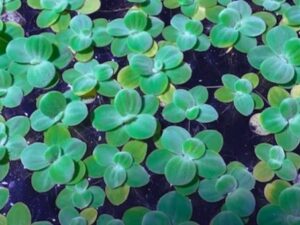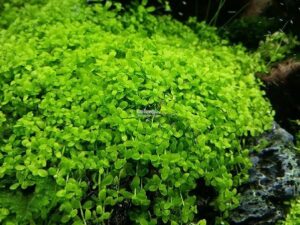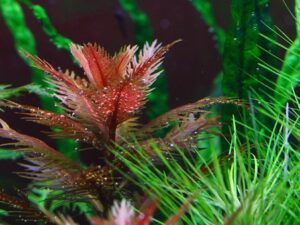Here, we discuss care for Telanthera Cardinalis. Telanthera Cardinalis is soo common in the aquatic world that it is misused for many aquatic plants. They can be challenging to identify as many plants have a similar appearance, but don’t you worry; we have covered many topics with a detailed description of this plant.
The Telanthera Cardinalis is a unique plant with wide varieties to choose from. The coloration of the leaves of these plants adds new life to any boring aquarium. This is the reason why they are so popular among aquarists and hobbyists. They are perfect low-maintenance plants and are suitable for both experienced and beginners.
This article will provide information about scientific classification, care level, tank size, lighting needs, pH levels, temperature, propagation, etc. With the help of this article, you will be able to understand the basics of this plant.
You will learn many things like how to propagate this plant, understand the difference between different species similar to this plant, etc. So let us get started!
Species Summary
| Scientific name | Alternanthera reineckii |
| Common names | Blood parrot plant, Telanthera Cardinalis |
| Other names | Achyranthes Reineckii, Alternanthera Osiris |
| Family | Amaranthaceae |
| Origin | Brazil, South America |
| Care Level | Easy to Moderate |
| Size | 10-24 inches |
| Tank size | 10 gallons |
| pH levels | 6.5-7.5 |
| Temperature range | 75°-80.6° F (23.9°-27° C) |
| Lightning | Moderate to high |
The Telanthera Cardinalis’ full scientific name is Alternanthera reineckii; this includes two types, the Cardinalis, and the Rosaefolia. These two are very similar, but there is a way you can differentiate between them two.
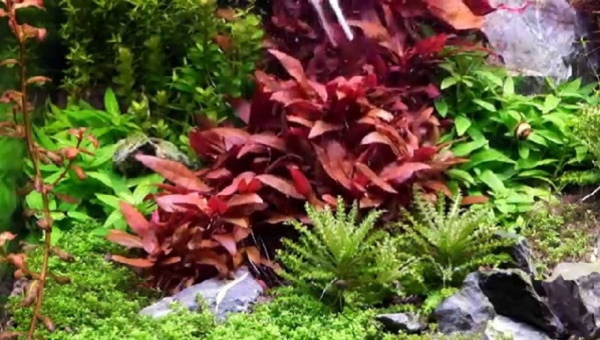
The cardinal has broad leaves, and the coloration is deep red; however, Rosaefolia’s leaves are longer and thinner and have lighter pinkish-red coloration. This plant comes from a big family with nearly 200 different species worldwide.
In your home tank, they grow up to 16 inches; in the wild, they can grow up to 24 inches. These are unique plants that add beautiful color to your tank. While buying your plan, you should ensure your plant is healthy.
A healthy plant will have beautiful deep red coloration with no holes in the leaves. You should always get your plant from a reputed pet store or a reputed seller to ensure you get a healthy plant. This will ensure the beauty and safety of your aquarium.
Check 15 Best Floating Plants For Your Aquarium
Telanthera Cardinalis Appearance and Physical Characteristics
Telanthera Cardinalis is an aquatic plant with a beautiful color combination of green and red. The leaves are oval and perpendicular to each other. This pattern is known as decussate. The edges of the leaves are toothed with dark-green color, and the base of the leaves has a red hue.
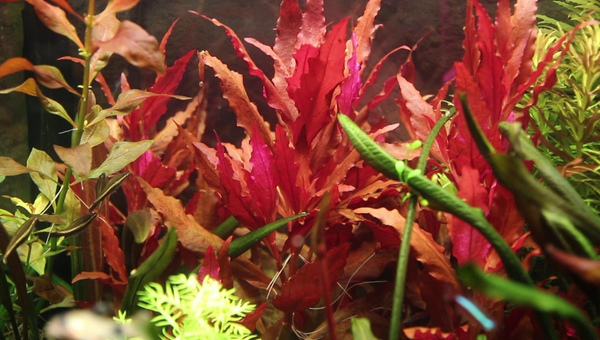
Although the color depends on the environment, it is mainly green. The leaves closer to the surface are reddish, while the leaves closer to the base are green.
The leaves of this plant are fascinating as the leaves have no stalks. They are approximately 1 inch long and 0.2 to 0.6 inches wide. The roots of this plant are fibrous, long, and thin.
Also, check Amazon Sword Plant: Best Detailed Guide
Telanthera Cardinalis Variations in Appearance
There are many variations in the appearance of this plant due to its wide distribution. The most common variation is in the color of the leaves. Alternanthera reineckii rosaefolia has pink veins and a pinkish or purplish hue, not a deep red.
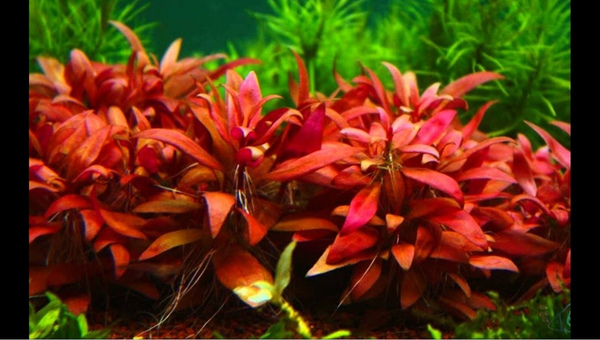
The dwarf varieties of this plant are known as Alternanthera reineckii “Mini” or “Nana.” This plant is purple or pinkish and grows in a cardinal pattern.
Telanthera Cardinalis Habitat and Distribution Around the World
This plant is native to Brazil but is now found in many parts of the world, like South America, Europe, etc. This plant is found in many countries like Brazil, Argentina, Paraguay, Uruguay, etc. They have become trendy worldwide because of their unique looks and several benefits for your inhabitants.
Also, check Water Sprite Plant: Best Care Guide Explained in Details
Habitat and Environment in the Wild
This plant prefers to live in slow-moving waters. Because of its native marshy habitat, it is called the paludal plant. It can grow as a malarial plant, which means it can be rooted under the water and survive above the water’s surface or completely underwater.
This makes it a versatile plant. These plants are often seen in fields flooded with water in the wild, and their tops can easily be seen above the water’s surface.
Telanthera Cardinalis Typical Features/Behavior
When planted underwater, the Telanthera Cardinalis stems will grow vertically and quickly emerge from underwater; this makes the branches grow above the waterline. This is mainly seen in the wild, a palladium, or an aquarium not filled to the top.
Telanthera Cardinalis behave this way because this plant has ” floatation organs.” These organs help the plant keep itself above water when not submerged. The leaves of this plant have a high density, and when the plant grows tall, the weight of the leaves makes the stem bend.
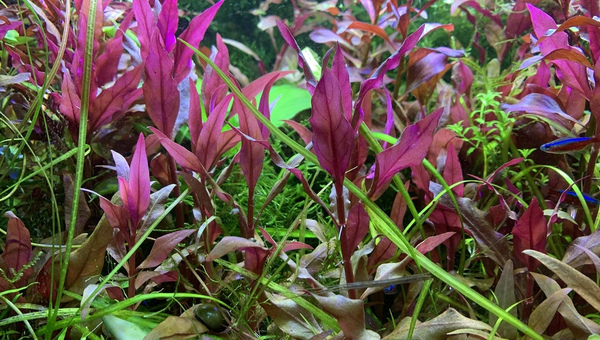
So, if you want to grow this plant emersed, you must provide some support for the stem. Another reason is they are adapting themselves for ground growing. They will shed their leaves if you clip the shoots and submerge them again.
Telanthera Cardinalis can also be used as a pond plant. This is because it can survive in both submerged and emerged forms. When grown in ponds, this plant provides shelter and hiding places for the fish. It also helps to oxygenate the water and keeps the water clean.
A feature of the dwarf version of Alternanthera reineckii is that the parent plant produces many shoots and shows carpet growth on the aquarium substrate. You should consider this feature when by this plant to curate your aquascape.
It would help if you also remember that this plant has a fragile root system. This plant tends to come out of the substrate. You don’t have to do much if this happens to your plant. Just push the plant back gently into the substrate and cover it with more substrate.
Allow the plant cutting to float in the water till they grow nice and thicker roots, and then plant it in the substrate.
You may also check 31 Best Low Light Aquarium Plants
Telanthera Cardinalis Care Guide
This plant is not difficult to care for. They are easy to moderate in terms of care. You should provide them with good lighting and water conditions, and they will thrive in your tank.
To ensure optimal growth, you should trim the plant regularly. You can do this by pinching. This will help the plant to grow bushier. You can trim the plant by cutting it back to the desired size. When you trim the plant, ensure you do not damage the roots, which will cause the plant to rot.
You should also fertilize the plant regularly with a good quality fertilizer. This will provide them with the nutrients they need to grow and thrive. You should fertilize the plant every two weeks with liquid fertilizer or every month with a fertilizer tablet.
Also, check Jungle Val- Planting Procedure & Care Guide
Tank Conditions
The tank size matters when you are growing Alternanthera reineckii. A minimum of 10 gallons is required for this plant. But, if you want to grow it emerged, a 20-gallon tank is recommended. This plant can also be grown in brackish water but does better in freshwater.
The substrate should be rich in nutrients and should be loose. Although this plant gets most of its nutrition from the water, a good-quality substrate is necessary. These plants require about 0.75 inches of sand, mud, or gravel.
You should also add a layer of mulch on top of the substrate to help the plant retain moisture. They should be planted in the tank’s background or midground. This very fragile plant can break easily, so be careful while producing it.
You may also check Otocinclus Catfish Care Guide: Appearance, Lifespan, Food & Diet, Breeding & All
Water Conditions
This plant can grow in a wide range of water conditions. But, to achieve optimal growth, you should maintain the freshness of the water in the tank. This is because it gets its nutrition from water, and the plant’s growth depends on water quality.
It would be best if you did partial water changes every week to maintain the freshness of the water. You should also add water fertilizer tablets like the CO2 injections. This will help the plant to achieve optimal growth. They do best in a tropical tank, so try to imitate their natural habitat in South America.
The temperature of the water should be between 75°-80.6° F (23.9°-27° C). The pH level of the water should be between 6.5 and 7.5, and the hardness of the water should be between 5 and 15 dGH.
You may also check Butterfly Betta Care Guide: Appearance, food & Diet, Breeding & All
Lighting and Filtration Requirements
This plant requires moderate to bright lighting. If you are growing them emerged, they can tolerate low-lighting conditions, but high lighting is recommended for optimal growth. Moderate lighting will ensure the coloration and growth of the plant.
If you can not provide them with natural light, you can use a lamp, but direct sunlight is best. If you are using artificial light, watch the timing and placement of the lamp, as the shoots can burn under direct artificial light.
The tank’s filtration system should be good enough to remove the toxins from the water. This will ensure enough nutrition reaches your plants and that no toxins are present in the water to stop your plant from growing.
Also, check Clown Pleco 101:Care, Diet, Lifespan, Food & Diet, Breeding & All
Telanthera Cardinalis Propagation
Alternanthera reineckii can be propagated by stem cuttings or by dividing the plant. The best time to propagate this plant is in spring or summer.
To propagate by stem cuttings, take a sharp knife and cut a 4 to 6-inch cutting from the mother plant. Remove the leaves from the lower 2/3 of the stem. Dip the cut end of the stem in a rooting hormone and plant it in a loose substrate.
Water the substrate well and keep it moist but not waterlogged. In about 4 to 6 weeks, you should see new growth on the cutting.
To propagate by division, carefully remove the mother plant from the substrate. Pull the plant apart into two pieces, ensuring each has roots. Plant each piece in a loose substrate and water the well. In about 4 to 6 weeks, you should see new growth on each plant.
Check Royal Pleco Best Care Guide, Species Summary & All
Telanthera Cardinalis Potential Problems
One of the most common problems with Alternanthera reineckii is that it gets stunted growth. This is usually due to a lack of nutrients in the water or substrate. Add a fertilizer tablet to the water to fix this problem and ensure the substrate is nutrient-rich.
Another common problem is that the leaves turn yellow and fall off. This is usually due to a lack of light or a build-up of toxins in the water. You should increase the lighting and ensure the filtration system works properly to fix this problem.
Telanthera Cardinalis Compatibility and Tank Mates
Alternanthera reineckii is a peaceful plant and can be kept with most fish. However, it is recommended that you keep them with smaller fish as they might nibble on the plant’s leaves. Some good tank mates for Alternanthera reineckii include:
They should not be kept with fish that are known to nibble on plants, such as Goldfish and Bettas. Bigger fish might uproot the plant when they swim around, so it is best to avoid them.
Conclusion
Alternanthera reineckii is a beautiful plant that can add color and interest to your aquarium. They are easy to care for and can tolerate various water conditions. Alternanthera reineckii will thrive in your aquarium and provide you with years of enjoyment with proper care.
Also, check Betta Fish 101: Diet, Lifespan, Size, Care Guide & All
We hope you have found this article helpful and feel confident in your ability to care for Alternanthera reineckii. We focused on the plant’s general care, propagation, and compatibility.
We expect that with this article, you will have all the information you need to ensure that your Alternanthera reineckii plant is healthy and happy in your aquarium. Thank you so much for reading!

